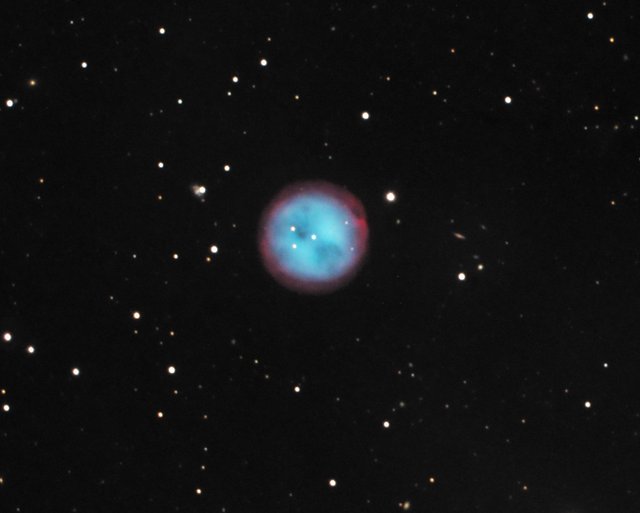Astronomical observations #19 : Owl Nebula (M97)
Welcome to the next part of my cycle dedicated to amateur astronomical observations. Today, another object of deep sky, which is worth seeing by an amateur telescope. M97 is a planetary nebula found in the constellation Ursa Major. This is a small object with medium search difficulty. It should not be a problem under a good dark sky.

By Stargazer 7000 link [Public domain]
Above photography with a long exposure time showing the color of the object. The Owl Nebula is a small object with an angular diameter of about 3 arc minutes and a brightness of +10 magnitude. This nebula is located near the back of the Big Dipper. It is difficult to find this object with binoculars. When we can find it using a telescope with a diameter of 8 inches, we will see the view as in the simulation below. It will be a gray, slightly fuzzy oval. Using a larger magnification will allow you to extract additional details, and in larger instruments will allow you to see the outline of the dark ''eyes of an owl''. There are special nebulizer filters that allow you to enhance the contrast between the object and the sky background. This filter gives a significant improvement of the image in the case of M97. You can also use the method of peeking into the telescope eyepiece from the eye. This allows you to see more by directing the faint light of the nebula to the more sensitive side fragments of the retina.

My own work
The M97 planetary nebula was formed from discarded layers of a dying star. This object is located about 2,000 light-years from Earth and in fact has a diameter of 2-3 light years. Its central star shines faintly and has +14 magnitude. It is within the range of telescopes with a diameter of over 12 inches. The owl lies in the vicinity of the spiral galaxy M108, which I will describe to you in future articles of the series, when I pass this topic of observation of galaxies. I encourage you to observe the deep sky objects away from the lights of the city and on a moonless night. Only such conditions will allow to see the true beauty of these low-light objects. Every cloudless night above our heads opens a window to the universe around us, let's use it!
Greetings to lovers of Astronomy!
References:

This post has been upvoted for free by @microbot with 0.1%!
Get better upvotes by bidding on me.
More profits? 100% Payout! Delegate some SteemPower to @microbot: 1 SP, 5 SP, 10 SP, custom amount
You like to bet and win 20x your bid? Have a look at @gtw and this description!
The night sky is a wonderland. You really know you way are the stars. Thanks for posting @astromaniac
Hello @astromaniac, thank you for sharing this creative work! We just stopped by to say that you've been upvoted by the @creativecrypto magazine. The Creative Crypto is all about art on the blockchain and learning from creatives like you. Looking forward to crossing paths again soon. Steem on!